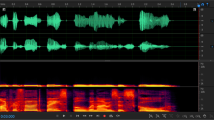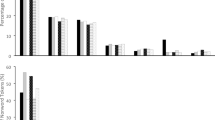Abstract
In this dichotic listening study, monosyllabic tasks were conducted in both English and Chinese to evaluate (1) the effects of processing two acoustically different languages and (2) the effects of bilingualism. One subject group included 28 bilingual speakers of English and Chinese, and a second group in cluded 29 monolingual English speakers. Three pairs of monosyllabic words were presented such that each ear received a different word at the same time. Twenty such sets in both languages were presented, with recall order irrelevant. The results show that the monolingual English subjects demonstrated a significant right ear advantage when identifying English words dichotically, suggesting a left hemisphere processing component. However, there was no ear effect when the English-Chinese speakers performed the dichotic listening tasks in both Chinese and English. It appears that, with the acquisition of a second language, right ear dominance seems to be replaced by interhemispheric processing.
Similar content being viewed by others
References
Albert, M., & Obler, L. (1978).The bilingual brain: Neuropsychological and neurolinguistic aspects of bilingualism. New York: Academic Press.
Baudoin-Chial, S. (1986). Hemispheric lateralization of modern standard Chinese tone processing.Journal of Neurolinguistics, 2, 189–199.
Baum, S., Kelsh-Daniloff, J., Daniloff, R., & Lewis, J. (1982). Sentence comprehension by Broca's aphasics: Effects of some suprasegmental variables.Brain and Language, 17, 261–271.
Bryden, M. P. (1963). Ear prefence in auditory perception.Journal of Experimental Psychology, 65, 103–105.
Curry, F. (1966).A comparison of left-handed and right-handed subjects on five verbal and non-verbal dichotic listening tasks. Unpublished doctoral dissertation, Northwestern University, Evanston, IL.
Curry, F. (1967). A comparison of left-handed and right-handed subjects on verbal and non-verbal dichotic listening tasks.Cortex, 3, 343–352.
Curry, F. (1968). A comparison of the performances of a right hemipherectomized subject and 25 normals on four dichotic listening tasks.Cortex, 4, 144–153.
Cutting, J. (1972). Ear advantages for stops and liquids in initial and final positions. InHaskins Laboratories report on speech research (pp. 31–32). New Haven, CT: Haskins Laboratories.
Galloway, L., & Scarcella, R. (1982). Cerebral organization in adult second language acquisition: Is the right hemisphere more involved?Brain and Language, 16, 546–560.
Gao, S., & Benson, F. (1990). Aphasia after stroke in native Chinese speakers.Aphasiology, 4(1), 31–42.
Genesee, F., Hamers, J., Lambert, W. E., Mononen, L., Seitz, M., & Starck, R. (1978). Language processing in bilinguals.Brain and Language, 5, 1–12.
Haggard, M. (1971). Encoding and the REA for speech signals.Quarterly Journal of Experimental Psychology, 23, 34–45.
Ke, C. (1988).A comparison of dichotic processing: English versus Chinese. Paper presented at the 1988 Linguistic Society of America Annual Conference, New Orleans.
Kimura, D. (1961a). Cerebral dominance and the perception of verbal stimuli.Canadian Journal of Psychology, 15, 166–171.
Kimura, D. (1961b). Some effects of temporal-lobe damage on auditory perception.Canadian Journal of Psychology, 15, 156–165.
Kimura, D. (1964). Left-right differences in the perception of melodies.Quarterly Journal of Experimental Psychology, 16, 355–358.
Kimura, D. (1967). Functional asymmetry of the brain in dichotic listening.Cortex, 3, 163–178.
Ladefoged, P. (1982),A course in phonetics, New York: Harcourt Brace Jovanovich.
Lieberman, P. (1977).Speech physiology and acoustic phonetics: An introduction, New York: Macmillan.
Packard, J. (1986). Tone production deficits in aphasic Chinese speech.Brain and Language, 29, 212–223.
Poizner, H., Klima, E., & Bellugi, U. (1987).What the hands reveal about the brain. Cambridge, MA: MIT Press.
Ryalls, J. (1984). Some acoustic aspects of fundamental frequency of CVC utterances in aphasia.Phonetica, 41, 103–111.
Ryalls, J., & Reinvang, I. (1986). Functional lateralization of linguistic tones: Acoustic evidence from Norwegian,Language and Speech, 29, 389–398.
Shankweiler, D., & Studdert-Kennedy, M. (1967). Identification of consonants and vowels presented to left and right ears.Quarterly Journal of Experimental Psychology, 19, 59–63.
Shanon, B. (1982). Lateralization effects in the perception of Hebrew and English words.Brain and Language, 17, 107–123.
Silverberg, R., Bentin, S., Gaziel, T., Obler, L. K., & Albert, M. L. (1979). Shift of visual field preference for English words in native Hebrew speakers.Brian and Language, 8, 184–190.
Smith, T., & Shand, M. (1974).Dichotic perception of initial consonants and lexical tone in Cantonese. Report presented at the 87th Meeting of the Acoustical Society of America, New York.
Sussman, H., Franklin, P., & Simon, T. (1982). Bilingual speech: Bilingual control?Brain and Language, 15, 125–142.
Thomas, H. L. (1987).Effects of different acoustic characteristics in language processing: A dichotic listening study of Mandarin-English speakers. Unpublished doctoral dissertation, Indiana University, Bloomington.
Vaid, J., & Lambert, W. E. (1979). Differential cerebral involvement in the cognitive functioning of bilinguals.Brain and Language, 8, 92–110.
Van Lancker, D., & Fromkin, V. (1973). Hemispheric specialization for pitch and “tone”: Evidence from Thai.Journal of Phonetics, 1, 101–109.
Van Lancker, D., & Fromkin, V. (1978). Cerebral dominance for pitch contrasts in tone language speakers and musically untrained and trained English speakers.Journal of Phonetics, 6, 19–23.
Author information
Authors and Affiliations
Additional information
I would like to express my deep appreciation to John Ryalls for his efforts in the preparation of this article. Thanks also go to Stuart Davis, Steven Chin, Sven Anderson, David Pisoni, and two anonymous reviewers for their critical comments on previous drafts.
Rights and permissions
About this article
Cite this article
Ke, C. Dichotic listening with Chinese and English tasks. J Psycholinguist Res 21, 463–471 (1992). https://doi.org/10.1007/BF01067524
Issue Date:
DOI: https://doi.org/10.1007/BF01067524




